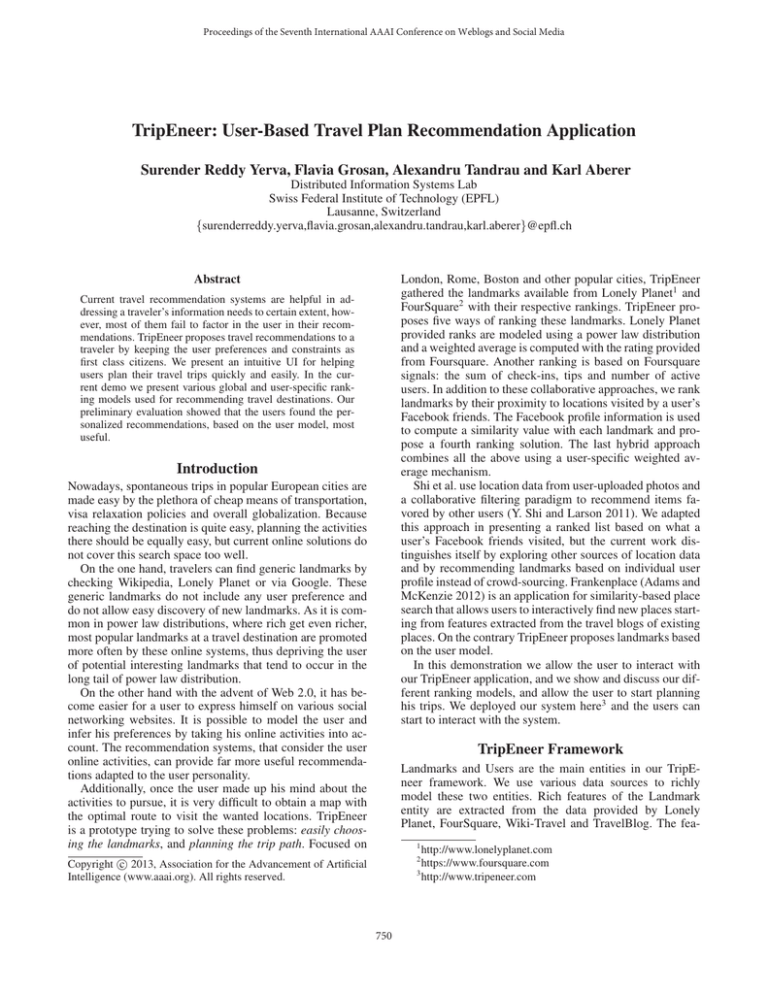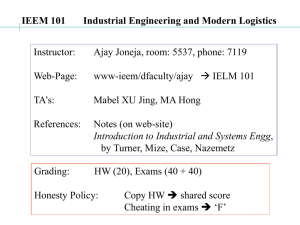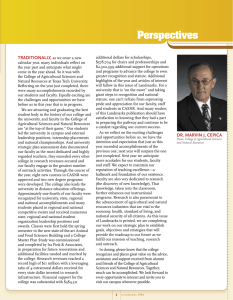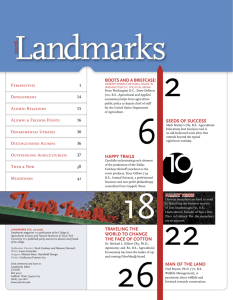
Proceedings of the Seventh International AAAI Conference on Weblogs and Social Media
TripEneer: User-Based Travel Plan Recommendation Application
Surender Reddy Yerva, Flavia Grosan, Alexandru Tandrau and Karl Aberer
Distributed Information Systems Lab
Swiss Federal Institute of Technology (EPFL)
Lausanne, Switzerland
{surenderreddy.yerva,flavia.grosan,alexandru.tandrau,karl.aberer}@epfl.ch
Abstract
London, Rome, Boston and other popular cities, TripEneer
gathered the landmarks available from Lonely Planet1 and
FourSquare2 with their respective rankings. TripEneer proposes five ways of ranking these landmarks. Lonely Planet
provided ranks are modeled using a power law distribution
and a weighted average is computed with the rating provided
from Foursquare. Another ranking is based on Foursquare
signals: the sum of check-ins, tips and number of active
users. In addition to these collaborative approaches, we rank
landmarks by their proximity to locations visited by a user’s
Facebook friends. The Facebook profile information is used
to compute a similarity value with each landmark and propose a fourth ranking solution. The last hybrid approach
combines all the above using a user-specific weighted average mechanism.
Shi et al. use location data from user-uploaded photos and
a collaborative filtering paradigm to recommend items favored by other users (Y. Shi and Larson 2011). We adapted
this approach in presenting a ranked list based on what a
user’s Facebook friends visited, but the current work distinguishes itself by exploring other sources of location data
and by recommending landmarks based on individual user
profile instead of crowd-sourcing. Frankenplace (Adams and
McKenzie 2012) is an application for similarity-based place
search that allows users to interactively find new places starting from features extracted from the travel blogs of existing
places. On the contrary TripEneer proposes landmarks based
on the user model.
In this demonstration we allow the user to interact with
our TripEneer application, and we show and discuss our different ranking models, and allow the user to start planning
his trips. We deployed our system here3 and the users can
start to interact with the system.
Current travel recommendation systems are helpful in addressing a traveler’s information needs to certain extent, however, most of them fail to factor in the user in their recommendations. TripEneer proposes travel recommendations to a
traveler by keeping the user preferences and constraints as
first class citizens. We present an intuitive UI for helping
users plan their travel trips quickly and easily. In the current demo we present various global and user-specific ranking models used for recommending travel destinations. Our
preliminary evaluation showed that the users found the personalized recommendations, based on the user model, most
useful.
Introduction
Nowadays, spontaneous trips in popular European cities are
made easy by the plethora of cheap means of transportation,
visa relaxation policies and overall globalization. Because
reaching the destination is quite easy, planning the activities
there should be equally easy, but current online solutions do
not cover this search space too well.
On the one hand, travelers can find generic landmarks by
checking Wikipedia, Lonely Planet or via Google. These
generic landmarks do not include any user preference and
do not allow easy discovery of new landmarks. As it is common in power law distributions, where rich get even richer,
most popular landmarks at a travel destination are promoted
more often by these online systems, thus depriving the user
of potential interesting landmarks that tend to occur in the
long tail of power law distribution.
On the other hand with the advent of Web 2.0, it has become easier for a user to express himself on various social
networking websites. It is possible to model the user and
infer his preferences by taking his online activities into account. The recommendation systems, that consider the user
online activities, can provide far more useful recommendations adapted to the user personality.
Additionally, once the user made up his mind about the
activities to pursue, it is very difficult to obtain a map with
the optimal route to visit the wanted locations. TripEneer
is a prototype trying to solve these problems: easily choosing the landmarks, and planning the trip path. Focused on
TripEneer Framework
Landmarks and Users are the main entities in our TripEneer framework. We use various data sources to richly
model these two entities. Rich features of the Landmark
entity are extracted from the data provided by Lonely
Planet, FourSquare, Wiki-Travel and TravelBlog. The fea1
http://www.lonelyplanet.com
https://www.foursquare.com
3
http://www.tripeneer.com
2
c 2013, Association for the Advancement of Artificial
Copyright Intelligence (www.aaai.org). All rights reserved.
750
Figure 2: TripEneer Application: The map showing the landmarks visited by users friends. The heat-map view provides
a social context to the landmarks.
Figure 1: TripEneer Application: The various tabs showing
different rankings. The heat-maps showing the popularity of
various landmarks.
WorkFlow: The user logins to TripEneer application using his Facebook credentials. TripEneer creates a user model
based on the information extracted from the users Facebook profile. Next when the user chooses a travel destination
from the Dashboard (for example: London), the application
provides landmark recommendations under different rankings tab. The user chooses different landmarks by exploring
the different ranking tabs. The MyPlan-tab shows the set of
landmarks chosen by the user. The map view provides a simple tour proposed by the framework.
tures include description, popularity, geo-location coordinates, events and images of the landmark. A User model,
similar to the entity model (Yerva, Miklos, and Aberer
2012), is developed from the features extracted from the
user’s Facebook, Flickr and Personal Blog profiles.
TripEneer proposes five different ranking models, based
on the landmark and user features, for addressing the various
users requirements.
Guides Ranking: Provides ranking based on the popularity
of a landmark statistics accumulated by travel guides and
by crowd-sourcing websites. The guide rank was modeled
as a Zipf function. This value was averaged with the normalized crowd-sourcing rank.
Conclusion
In this paper we presented TripEneer, a personalized tour
planning application. When a user is planning to visit a certain tourist location, the TripEneer application helps recommending the landmarks specific to his user profile, along
with the general recommendations from Lonely Planet, Wiki
Travel, etc. Users can view the landmarks both in the classical travel guide way, or can discover new places which
match their preference. The users of the system liked the
personalized rankings provided by the system. The friendsbased ranking helped the users to readily identify which of
their friends have visited these landmarks and can be contacted for further information.
Check-ins Ranking: Considers the normalized number of
signals on Foursquare. These features indicate the activity
around a landmark.
Friends-based Ranking: Ranking based on proximity to locations visited by a user’s Facebook friends. The heatmap view provides a social context to the landmarks.
User-based Ranking: The user preference is modeled
through Facebook profile information such as: pages liked
by the user, about-me description and his posts. The landmarks are ranked using the distance-similarity function
between the user model and the landmarks description.
Acknowledgements
This work was partly funded by the NisB project (FP7-ICT256955).
Hybrid Ranking: The above four ranker values are averaged to obtain a combination of landmarks from all sections. The users can customize the weights for each score.
In the future work, we plan to infer these values based on
the users activity.
References
Adams, B., and McKenzie, G. 2012. Frankenplace: An Application for Similarity-Based Place Search. Proceedings
of the Sixth International AAAI Conference on Weblogs and
Social Media.
Y. Shi, P. Serdyukov, A. H., and Larson, M. 2011. Personalized Landmark Recommendation Based on Geotags from
Photo Sharing Sites. Proceedings of the Fifth International
AAAI Conference on Weblogs and Social Media.
Yerva, S. R.; Miklos, Z.; and Aberer, K. 2012. Entity-based
Classification of Twitter Messages. International Journal of
Computer Science and Applications.
We have crawled many popular locations for the TripEneer application. It contains 10 locations and on average 370
landmarks per destination. The framework is developed on
many scalable components and can be easily extended to
many more destinations with little effort. In our preliminary
evaluation we observed that personalized landmark recommendations were most useful to the user. The heat-maps corresponding to the landmarks visited by a user friends were
informative and useful to the user.
751






